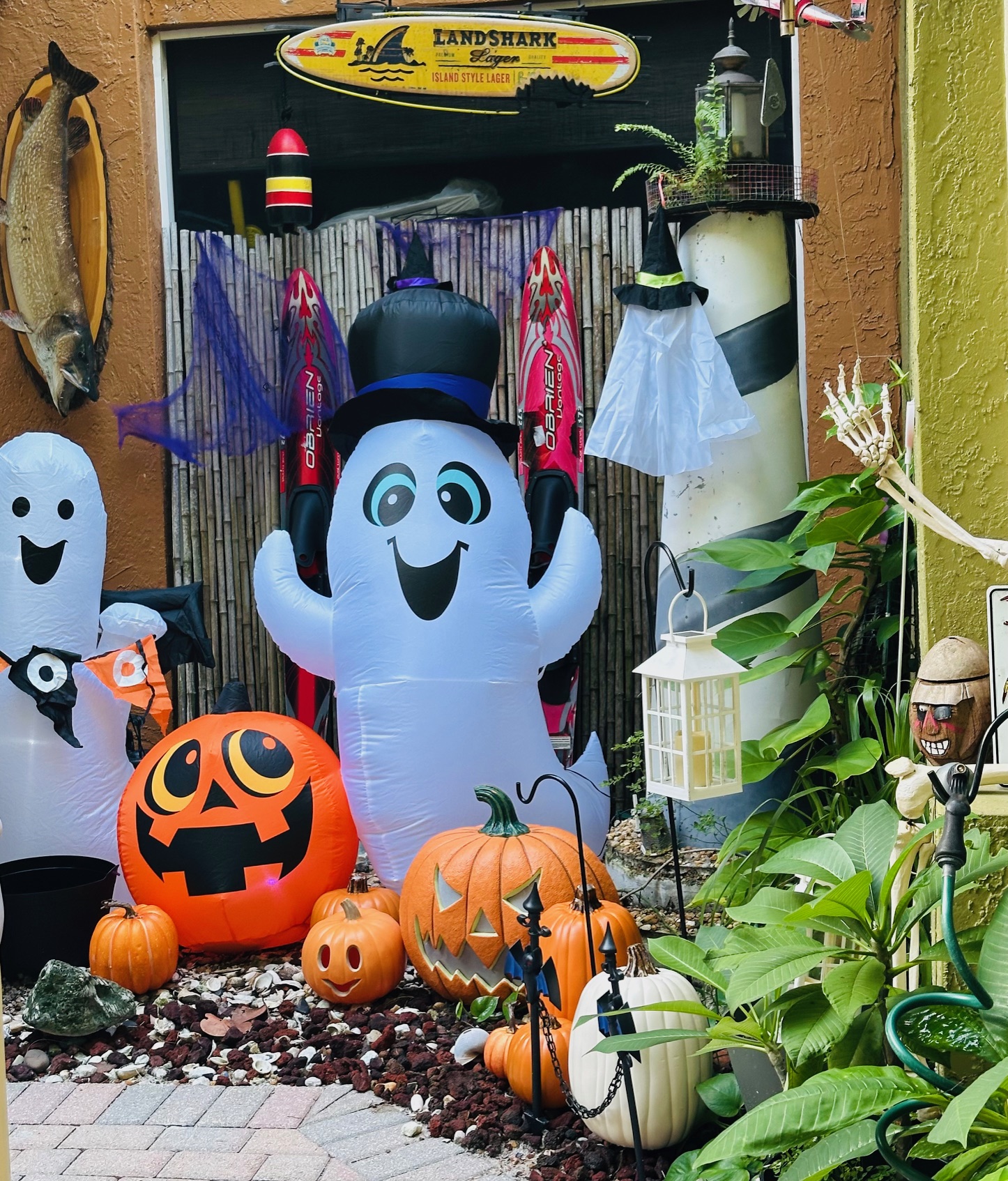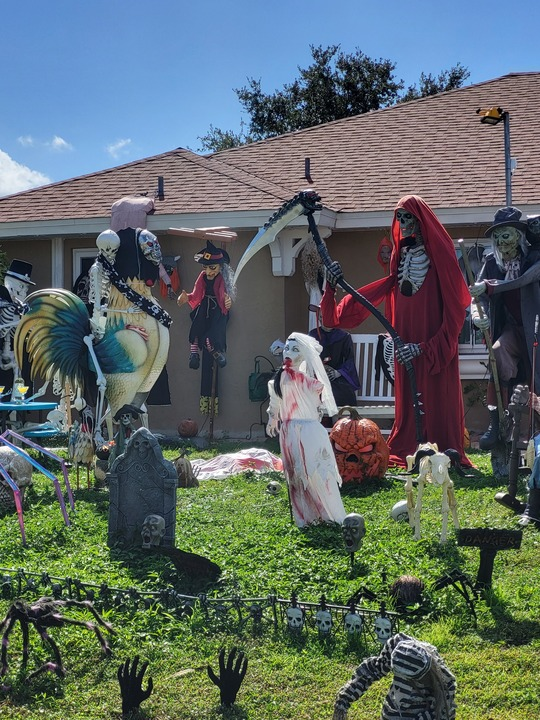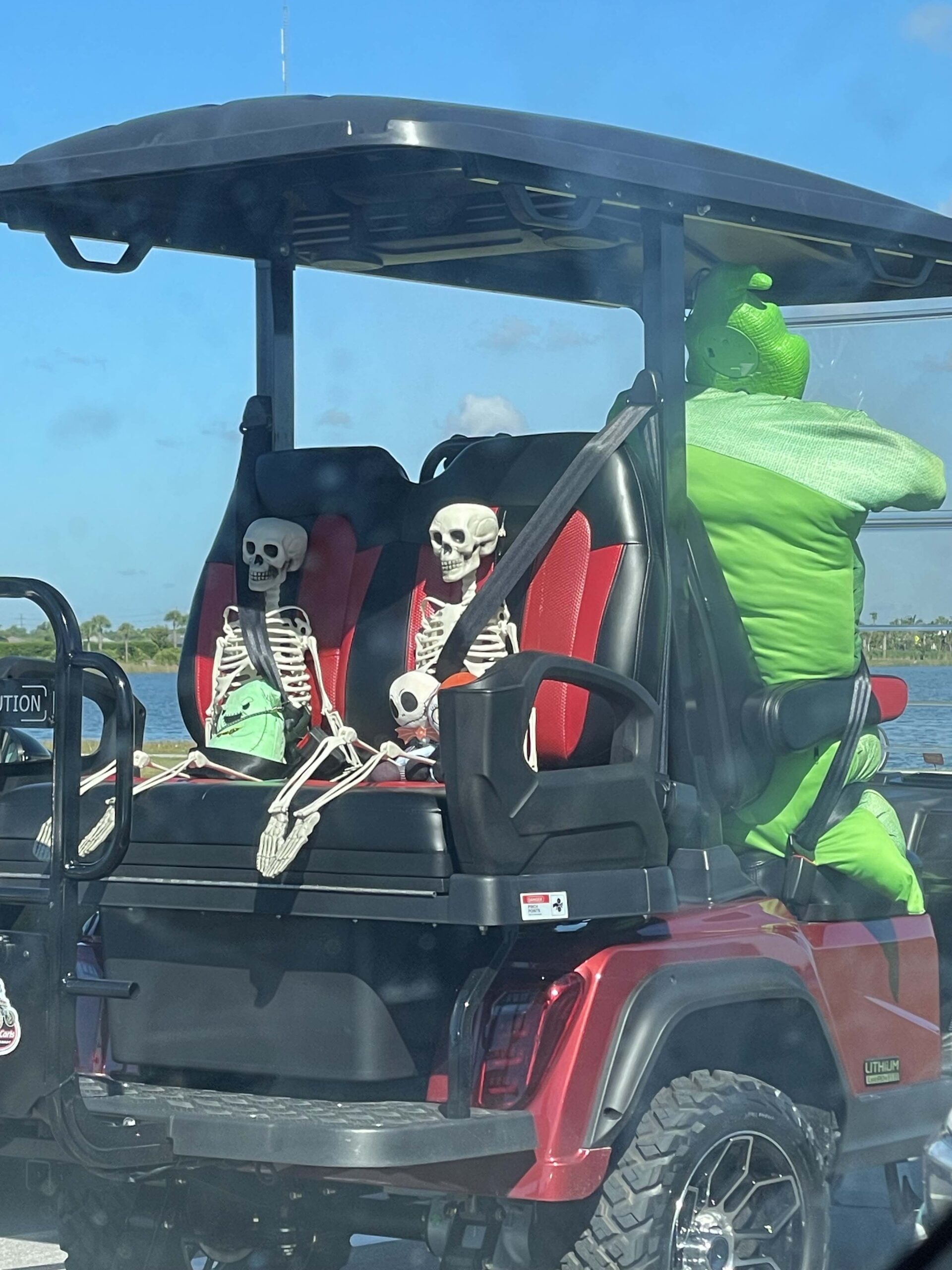
A festive Halloween scene in Boynton Beach mixes with the city’s strong fishing history. -COURTESY PHOTO
The mere passage of time, a lot of time, proves no detriment to the long arc of tradition when autumn arrives each year dressed in the bounty of harvests and — on the last day of October — costumed in the customs of Halloween.

A beautiful pumpkin patch at The Royal Poinciana Plaza on Palm Beach. -COURTESY PHOTO
From one pumpkin patch to another, from one costume shop, candy shelf or Halloween party to another, and certainly from one shining sea to another, a holiday celebrated in a variety of ways marks a turn toward late fall and winter that reaches into a pre-Christian past on the European continent and now in North America. It’s a past stretched across not just centuries, but millennia.
“Halloween was a magical time for me as a child,” recalls Scott Simmons, who grew up in the Rainbow Groves neighborhood of east Fort Myers and now serves as a spokesman for the Norton Museum of Art in West Palm Beach.
It was that way, and still is that way, for many Americans.
Florida, never a state to shy away from a good party, is chockablock with Halloween events, displays and opportunities.
In Palm Beach County, Bedner’s Farm Fresh Market on Boynton Beach is wrapping up its fall festival on Halloween with the still-populated pumpkin patch, tractor rides, corn maze, sunflowers, an animal adventure park and food; there are many individual parties such as The House of Horrors Halloween Graveyard at the Canitano’s House of Horrors on Boca Raton (“This graveyard walkthrough is safe for kids of all ages, and everyone is welcome,” says Connie O’Neil Canitano); or the Norton Museum of Art’s Art After Dark on Halloween event, where a DJ will be spinning tunes and rhythms.

A haunted attraction outside a Punta Gorda home. -BOB MASSEY / FLORIDA WEEKLY
On the southwest coast a drive through Victoria Park in Naples or San Carlos Park or the villas in Fort Myers or the Harbor Oaks community in Charlotte, not to mention the sprawling Babcock Ranch with its town center festively decorated in hay bales and orange pumpkins — or even just a spin down Retta Esplanade in Punta Gorda — will give you a tour that rivals Christmas for its decorative lights and household displays.
People here are celebrating a tradition that has become just plain fun for many. Not too terrifying, not too religious, and not too serious. It’s an E Pluribus Unum custom and holiday unmatched for its playfulness, perhaps, though it isn’t always quite what people expect.
“A friend last year got us an invitation to a party we heard for years was the place to be, and we went all out,” recalls Lyn Millner, who knows a thing or two about Americans who have indulged their sense of spiritualism and a spirit world, if you will, well beyond the parameters of mere American Halloweens; she’s the author of the celebrated book, “The Allure of Immortality: An American Cult, a Florida Swamp, and a Renegade Prophet,” describing the Koreshans’ elaborate, once-upon-a-time cult community in Estero.
“We went as Jack the Ripper and one of his victims, but only a few people dressed up, so we sort of sat on the couch,” she admits.
But that didn’t put her off the fun of Halloween. “I’m going to Farmer Mike’s Haunted Corn Maze in Bonita this year — it’s family fun. Last time I went, you could shoot zombies, there was hatchet throwing, the hayride was great and (people) were split evenly between who was going to the family maze, and who was going to the haunted maze.”
Elsewhere in Lee County, skeletons are sitting in the plush theater seats at the Alliance for the Arts. And at the Calusa Nature Center with its winding boardwalk through, well, nature, Florida style, there’s a little more than nature on October weekends through the 26th, with the annual Haunted Walk. You can even buy a VIP ticket and “Go straight to the fear. No waiting. No limits. Just pure terror!”

Assorted Halloween lawn decorations in Victoria Park. -DAVID WISHTISCHIN / FLORIDA WEEKLY
Once, long long ago, they may not have been kidding about the fear and terror on Halloween.
How it started
If your children are trick-or-treating this year, or if you’re in a costume at a costume party, especially if there are pumpkins and gourds in the room, you’re bringing together traditions that harken back to the ancient Celtic festival known as Samhain.
The word is pronounced sow-in, the historians say, marking a moment in time when they believed the world turned on a joint, opening for that one night a crack in the universe through which spirits could travel, and the living and dead might co-exist in the same place and time.
Those who wore masks did so to prevent the spirits from recognizing them, in some practices.
In that world, people built huge bonfires, sacrificed animals, burned produce and wore costumes, aiming to predict the future. When Roman culture predominated across parts of Britain and France, they not only commemorated their dead at the end of October but also celebrated the deities of the harvest in fruit and trees.
More than 10 centuries later, in the year 1,000, the Catholic Church created All Souls Day to celebrate the dead — that was on November 2, but the old traditions slipped through with it. All Saints Day or All-Hallowmas the day before on November 1, also included All-Hallows Eve, the night before that. All-Hallows Eve became Halloween in modern parlance.

Out and about at Babcock Ranch. -ROGER WILLIAMS / FLORIDA WEEKLY
That abbreviated history carries with it harvests, bonfires and remembrance of the dead, a fantastical dalliance with spirits (or a real dalliance in the minds of some), the tradition of goodies that became not just harvest bounty but candy or other sweets and money, in the American world, along with costumes. Originally worn to protect the wearer from recognition by malicious spirits, nowadays worn in part for the marvel and fun of participation in old but still novel customs.
Ghost stories, mischief making, singing and dancing — all of that became part of the American scene, along with trick-or-treating, with its obvious pleasures for children.
The historians’ version again: With the huge influx of Irish immigrants to America following the potato famine in the middle of the 19th century, the community-close practice of allowing children to walk house-to-house “begging” for food, coins and warm welcomes became part of our traditions.
Trick-or-treat customs became prevalent — everybody in a neighborhood sharing with their neighbors, in effect — and now Halloween is second only to Christmas as the nation’s largest commercial holiday: Americans will put out well over $11 billion, the second largest commercial holiday behind Christmas, economists estimate.
For Peter Bergerson, a professor emeritus at Florida Gulf Coast University who grew up in and around Long Beach, Indiana, Halloween was special because it meant a kind of freedom both to be something else and to roam, he says.
“I looked forward to the freedom of dressing up and going around with my buddies, and I looked forward to the candy, to be honest.”
As he recalls it now, “It was really a Norman Rockwellian environment, organized and designed for kids to be out and about, without supervision. Every door we went to, regardless of costume — they knew who we were.
“And sometimes when we said, ‘Trick or Treat, we had to do tricks.”
For Simmons, memories of Halloween run through his life like a river, steadily and unceasingly, perhaps, in a phenomenon that may be true for many.
“Orange River Elementary School, where my mother taught and where my siblings and I attended, held a Halloween carnival each year, complete with a spaghetti dinner – remember those?

A tree full of glowing jack-o-lanterns in Fort Myers. -DAVID WISHTISCHIN / FLORIDA WEEKLY
“Room 1 held a flea market with goodies donated by local families and there were baked goods prepared for sale, as I recall. I won a goldfish one year in a ring toss — the poor thing died before we made it home.
“In (my) Rainbow Groves neighborhood, the trick-or-treating was so good people from other neighborhoods dropped off their kids to beg for candy.
“One of our neighbors, Audrey Herrington, made the most beautiful cookies and bars to serve the boys and ghouls who haunted Rainbow Groves each Halloween. My sister, brother and I probably would have preferred the manufactured treats others served. But I’d give anything (now) for one of those nut bars Mrs. Herrington served at the corner of Rainbow and Rosemont drives.”
Costumes were often homemade. And it didn’t just stop there, as it hasn’t for Peter Bergerson, Lyn Millner or countless others.
“Later, when I attended Florida Atlantic University in Boca Raton,” Simmons recalls, “we screened “The Rocky Horror Picture Show” on an outdoor stage behind the University Center. Being outdoors made the cleanup much easier.
“I’ve been thinking of those evenings as the special 50th anniversary iteration of the show makes its way to performing arts centers across the country — it was fun seeing pictures on social media of my 50- and 60-something friends dressed in costume for the shows.”
One critic of Halloween called it “probably the most farcical holiday we have.”
Lyn Millner agrees.
“The most farcical and ridiculous holiday? Absolutely,” she says. “That’s what Halloween should be all about. It’s theater. It’s not real.”

